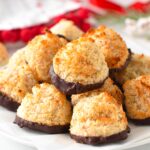These Almond Flour Coconut Cookies are easy almond flour cookies filled with chewy pieces of coconut flakes. It’s a delicious gluten-free treat made with minimal ingredients.

I love making all sorts of cookies. I’m a huge fan of experimenting with shapes (like my Almond Candy Cane Cookies), taste (you need to try my Maple Pecan Cookies), and texture (my favorite one is my new Almond Cloud Cookies).
These almond flour coconut cookies combine everything. A delicious coconut taste, a chewy and surprising texture, and any funky shape you want!
Ingredients and Substitutions
You only need 4 ingredients to make these cookies. Here’s how to pick them.

- Almond Flour – The base ingredient for these cookies, almond flour creates a soft texture while maintaining the gluten-free nature of the recipe. Almond meal can be used as a substitute, but it will result in darker and slightly grittier cookies. Other flours, such as oat or wheat, cannot be used here because they would alter the flavor and texture significantly.
- Unsweetened Flaked Coconut – This adds a chewy texture and rich coconut flavor to the cookies. You can use unsweetened shredded coconut as a substitute, adjusting the amount to maintain the right dough consistency. Feel free to saturate the dough with more coconut flakes. Add up to an extra 1/4 cup but watch out, you should still be able to squeeze the dough and form a ball without it being too crumbly or fragile. Too much coconut flakes would make the dough crumbly, not moist.
- Coconut Oil – This provides moisture and a subtle coconut undertone while helping the cookies hold together. Melted plant-based butter can be used as a swap for a slightly richer flavor, but avoid solid oils like shortening, as they don’t provide the same moisture or binding.
- Maple Syrup – The liquid sweetener that binds the dough and adds a natural sweetness. Alternatives like agave syrup or coconut nectar work well, but avoid thicker syrups like date syrup, as they may weigh down the dough.
- Coconut Extract (Optional) – It intensifies the coconut flavor for those who love a bolder tropical taste. If omitted, the cookies will still have a pleasant coconut profile from the flakes and oil. Vanilla extract can be used as a substitute for a milder and slightly sweeter flavor.
How to Make Almond Flour Coconut Cookies
These cookies are super easy to whip up. The secret is all about the consistency of the dough with the coconut flakes.

Pour all the ingredients into a large mixing bowl.

Stir the mixture until sticky and form cookie dough balls with your hands or with a cookie scoop.

Place the cookie dough balls on a baking sheet lined with parchment paper and flatten them with your hands.

Bake the cookies for 12-15 minutes at 350 °F (180 °C).
Carine’s Tips
I have a few more tips for you to make the very best cookies:
- Balance Coconut Flakes Carefully – Start with 1/2 cup of flakes and test the dough. Add up to 1/4 cup more, but stop if the dough becomes too dry or crumbly, as the cookies may not hold together.
- Choose the Right Coconut Form – Use large flakes for the chewiest texture, but if substituting shredded coconut, use slightly less to avoid overwhelming the dough structure.
- Keep Coconut Oil Cool – Ensure melted coconut oil is cooled (but not solid) before adding it to the dough to prevent prematurely melting the maple syrup and affecting the consistency.
- Use Gloves or Grease Hands for Shaping – This dough is sticky, so lightly oil your hands or wear gloves to shape and flatten the cookies easily.
- Experiment with Add-Ins – This recipe is very versatile. You can stir in mini chocolate chips, dried cranberries, or finely chopped nuts like pistachios for extra flavor and texture.
- Monitor Baking Time – Remove the cookies as soon as the edges turn golden brown. They may feel soft, but they will firm up as they cool.
- Cool Completely Before Handling – Allow cookies to rest for at least 15 minutes on the baking sheet to firm up before transferring to a cooling rack. Handling them too soon may cause breakage.
- Avoid Overmixing the Dough – Mix just until combined to prevent the cookies from becoming dense or losing their delicate texture.
- Test for Consistency – Squeeze a bit of dough in your hand; it should hold together without crumbling. If it’s too dry, add a teaspoon of maple syrup or coconut oil and mix again.
Storage Tips
You can store at room temperature for up to 2-3 days, or refrigerate in an airtight container for up to 4 days for maximum chewiness. To freeze, place the cookies in a single layer in a freezer bag. Thaw overnight in the fridge or for 1 hour at room temperature before serving.

More Cookie Recipes with Coconut
Did You Like This Recipe?
Leave a comment below or head to our Facebook page for tips, our Instagram page for inspiration, our Pinterest for saving recipes, and Flipboard to get all the new ones!

Almond Flour Coconut Cookies
Ingredients
- 1 cup Almond Flour - (note 1)
- ½ cup Unsweetened Flaked Coconut - +1/4 cup if desired (note 2)
- 3 tablespoons Coconut Oil - melted, cooled (note 3)
- ¼ cup Maple Syrup - (note 4)
Optional
- ½ teaspoon Coconut Extract - for a boost of coconut flavor
Instructions
- Preheat the oven to 350 °F (180 °C). Line a large baking sheet with parchment paper. Lightly oil the paper with cooking oil spray. Set aside.
- In a mixing bowl, add almond flour and coconut flakes. Start with 1/2 cup and see later if you want to add more – maple syrup, and melted coconut oil. Add the optional coconut extract.
- Stir with a rubber spatula then lightly oil your hands or wear gloves to knead the dough and press the ingredients together to form a soft cookie dough.
- Stir to form a sticky cookie dough, then grab about 2 tablespoons and place on the prepared baking sheet leaving half a thumb of space between each. I made 8 cookies.
- Sprinkle a few extra coconut chips on top and press on the top with your hand to stick and lightly flatten each cookie.
- Bake the cookies for 12-15 minutes at 350 °F (180 °C) until golden brown on the sides and top.
- Let the cookies cool down on the baking sheet for 15 minutes to firm up then on a cooling rack.








instead of maple syrup wat else we can use
Any liquid sweetener you love like agave syrup, coconut nectar.
Just wondering if I can substitute canola oil ? Will it affect the taste a bit?
It should work as well, you won’t have the same flavor as coconut oil add a coconut taste.
My family loved this!
can I substitute evoo for coconut oil? tx!
I personally don’t like the flavor of evoo in this cookie, but it works.